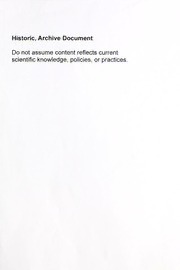
Seasonal wetland/waterfowl habitats created by water retention stuctures [sic] : a comparison : January, 1995 through April, 1997 : final report PDF
Preview Seasonal wetland/waterfowl habitats created by water retention stuctures [sic] : a comparison : January, 1995 through April, 1997 : final report
Historic, Archive Document Do not assume content reflects current scientific knowledge, policies, or practices. aQL696 .A5M39 1997 Agricultural United States Research Department of Service Agriculture National Sedimentation Laboratory SEASONAL WETLAND / WATERFOWL HABITATS CREATED BY WATER RETENTION STUCTURES: A COMPARISON January, 1995 through April, 1997 Final Report Prepared By: J. D. Maul and C. M. Cooper October, 1997 National Sedimentation Laboratory Research Report No. 6 USDA. Na*on«l Agricultural Library nal Blog , ,0301 Baltrmore BM National Agricultural library SEASONAL WETLAND / WATERFOWL HABITATS CREATED BY WATER RETENTION STUCTURES: A COMPARISON January, 1995 through April, 1997 Final Report Prepared By: J. D. Maul and C. M. Cooper October, 1997 National Sedimentation Laboratory Research Report No. 6 TABLE OF CONTENTS EXECUTIVE SUMMARY. ii INTRODUCTION. 1 DESCRIPTION OF THE STUDY AREA. 5 METHODS. 6 RESULTS. 9 Water Quality and Invertebrates. 10 Time-activity Budgets.11 Main Effects on Waterfowl Activities. 12 | Interaction Effects. 12 ■ Environmental and Biological Variables. 13 DISCUSSION. 14 Main Effects of Habitat and Season. 14 Season by Habitat Interactions. 17 Environmental and Biological Variables. 20 Conclusions. 22 ACKNOWLEDGMENTS. 24 LITERATURE CITED. 25 TABLE 1. 29 TABLE 2. 30 TABLE 3. 31 TABLE 4. 32 TABLE 5. 33 TABLE 6. 34 TABLE 7. 35 TABLE 8. 36 TABLE 9. 37 FIGURES. 38 I ' v«v; EXECUTIVE SUMMARY Winter flooding of agricultural fields reduces erosion and results in less herbicide costs by eliminating the necessity of spring weed burn-down. When fields collect and slowly release storm runoff, they reduce downstream flooding potential. Properly installed pipe outlets also prevent scouring as they convey water into channels. Casual observation shows that waterfowl use flooded fields over winter months. The purpose of this study was to document beneficial use to waterfowl of agricultural fields which were flooded during the winter by the use of field-scale water retention/control devices. Investigators have shown that waterfowl use of flooded fields was part of a broader strategy of using multiple habitats. Our specific goals were to (1) document use of flooded fields by waterfowl and (2) increase understanding of waterfowl behavior as influenced by seasonal flooding practices. We addressed these goals by determining: (1) if there is an effect of habitat type on behavioral activity budgets of non-breeding waterfowl, with comparisons between moist-soil and flooded agricultural habitats, and (2) if the activity budgets of these species in flooded agricultural habitats respond to selected environmental or social variables. The four species studied were green-winged teal (Anas crecca), northern shoveler (Anas clypeata), mallard (Anas platyrhynchos) and gadwall (Anas strepera). The response variables were waterfowl behaviors. Results include effects of habitat type and season on activities of non-breeding waterfowl. Gadwall feeding was greater in moist- soil wetlands than flooded rice while more time was spent resting in flooded rice fields. Time spent moving by northern shovelers and gadwall was greater in flooded rice than moist-soil. Time spent preening by mallards was greater in moist-soil habitats, and time that green-winged teal spent courting was greater in flooded rice fields than moist-soil. ii I SMB
